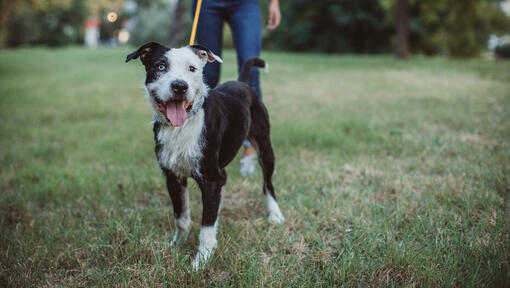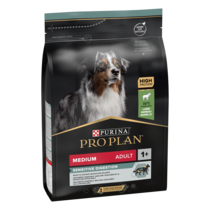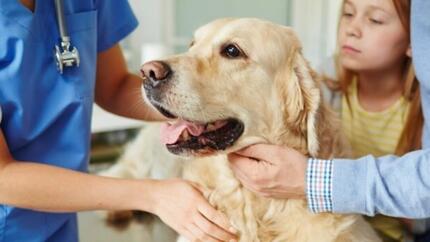
Gastroenteritis in dogs is a fairly common condition and will usually display as diarrhoea and sometimes vomiting too. Find out all you need to know about what causes it, the most common symptoms and the current veterinary treatments available.
If your dog has suddenly started having diarrhoea and perhaps vomiting as well, there’s a chance it may be dog gastroenteritis. This is a relatively common condition, typically occurring after the consumption of something unsavoury, but luckily with the right treatment it usually disappears relatively quickly.
At Purina, we’ve put together this guide to tell you all you need to know about gastroenteritis in dogs including the most common causes and the current treatment options available.
What is gastroenteritis in dogs?
Gastroenteritis in dogs is a condition that causes inflammation of the gastrointestinal tract (stomach and intestines). It will most commonly display as diarrhoea either with or without vomiting, where it can be just vomiting, this is far less common. Gastroenteritis can be either chronic (where it lasts for more than two weeks) or acute (this type doesn’t last long and will usually go away by itself in time, but may worsen as it goes on).
What causes gastroenteritis in dogs?
There can be many causes of gastroenteritis in dogs, including:
- Eating food that’s gone bad
- Ingesting foreign bodies
- Ingesting toxins
- Certain viruses or bacteria, such as parvovirus
- Liver and kidney disease
- Intestinal parasites, such as worms
- Food allergies
- Gastrointestinal ulcers
- Certain cancers of the gastrointestinal tract
Symptoms of gastroenteritis in dogs
- Vomiting (may appear foamy and yellow in colour once the stomach has been emptied)
- Diarrhoea
- Stomach pain
- Lack of appetite
- Gagging or dry heaving
- Lethargy
Haemorrhagic gastroenteritis in dogs
If you notice blood in your dog’s vomit or poop, it may be a sign of haemorrhagic gastroenteritis in dogs. Most commonly it will appear as almost a raspberry jam consistency in your dog’s stool and there may also be droplets of blood around your dog’s rectum. Haemorrhagic gastroenteritis is much more serious and urgent veterinary treatment will be required as soon as possible.
Diagnosing gastroenteritis in dogs
Gastroenteritis can usually be quickly diagnosed by a veterinary professional. Your vet will carry out a full examination, review their medical history and will likely ask you about their behavioural and eating habits over the past few days. They will want to know if your dog has eaten anything odd or if new foods have been introduced into their diet.
Treatment for gastroenteritis in dogs
The treatment will generally depend on what has caused the gastroenteritis. If the cause is related to ingesting unsavoury items, medication may be prescribed to stop the vomiting and/or diarrhoea. This may be advised along with a bland diet such as boiled chicken and rice or a prescription diet which can be purchased from your vet that’s specifically developed to treat intestinal issues like gastroenteritis.
If you are looking for more information on feeding your dog a blander diet involving rice, read this article to learn more.
Luckily, with prompt and correct treatment, gastroenteritis in dogs can clear up within a few days to a week. However, if it doesn’t seem to be going worse or you notice blood in their stool, take them back to the vet as soon as possible for further treatment.
If your vet suspects a case of haemorrhagic gastroenteritis in dogs, they may carry out X-rays and blood tests in order to look for foreign bodies or diseases. Additionally, it’s likely your dog will need fluids via an intravenous drip.
Preventing gastroenteritis in dogs
The long-term prevention of gastroenteritis in dogs can be a little difficult, especially if you don’t know what caused it to begin with, but there are a number of things you can do to reduce the risk of it returning in the future.
1. Discourage scavenging
If your dog’s a keen scavenger, try and discourage this while out on their walks. This may be difficult if they’re off the leash and tend to run off for a quiet munch, but if you believe this is the cause it may be best to keep them on the lead so this can be prevented.
2. Introduce any new foods slowly
Whenever you introduce new foods into your dog’s diet, do it slowly, usually over a couple of weeks. Where this may seem like a long time, it’s imperative to give your dog’s system time to adjust to the different food and ensure they don’t suffer from stomach upsets.
3. Keep up-to-date with vaccinations
Make sure you keep up-to-date with your dog’s vaccinations as this can prevent parvovirus. Parvovirus is a very contagious virus that can cause gastroenteritis in dogs and in some cases, can be fatal.
4. Ensure regular worming treatments
Always ensure you’re up-to-date with your worming medication. Certain worms can cause intestinal issues so by worming at least 4 times a year, you can ensure your dog is kept healthy, happy and parasite-free.
Now you know all about gastroenteritis in dogs, why not find out more about dog illness symptoms to watch out for with our guide on pancreatitis in dogs?








